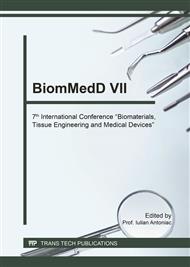[1]
Y. Chen, H. Liu, J. Gu, S. Yao, Therapeutic effect and safety of laparoscopic cervical cerclage for treatment of cervical insufficiency in first trimester or non-pregnant phase, Int J Clin Exp Med 8(5) (2015) 7710-7718.
Google Scholar
[2]
K. Kosinska-Kaczynska, D. Bomba-Opon, A. Zygula, B. Kaczynski, P. Wegrzyn, M. Wielgos, Adjunctive pessary therapy after emergency cervical cerclage for cervical insufficiency with protruding fetal membranes in the second trimester of pregnancy: a novel modification of treatment, Biomed Res Int. (2015).
DOI: 10.1155/2015/185371
Google Scholar
[3]
D. Gallot, D. Savary, H. Laurichesse, J.A. Bournazeau, J. Amblard, D. Lemery, Experience with three cases of laparoscopic transabdominal cervico-isthmic cerclage and two subsequent pregnancies, BJOG: an International Journal of Obstetrics and Gynaecology. 110 (2003).
DOI: 10.1046/j.1471-0528.2003.02272.x
Google Scholar
[4]
F.K. Lotgering, Clinical aspects of cervical insufficiency, BMC Pregnancy and Childbirth. 7(Suppl 1) (2007) : S17.
DOI: 10.1186/1471-2393-7-s1-s17
Google Scholar
[5]
M.U. Witt, SD Joy, J Clark, A Herring, W Bowes, JM Thorp, Cervicoisthmic Cerclage: Transabdominal Versus Transvaginal Approach, Am J Obstet Gynecol. 201(1) (2009) 105. e1–105. e4.
DOI: 10.1016/j.ajog.2009.03.020
Google Scholar
[6]
J.E. Shin, MJ Kim, GW Kim, DW Lee, MK Lee, SJ Kim, Laparoscopic transabdominal cervical cerclage: Case report of a woman without exocervix at 11 weeks gestation, Obstet Gynecol Sci. 57(3) (2014) 232-235.
DOI: 10.5468/ogs.2014.57.3.232
Google Scholar
[7]
J.E. Song, KY Lee, GH Son, Prediction of outcome for transabdominal cerclage in women with cervical insufficiency, Hindawi Publishing Corporation BioMed Research International 2015 (2015), 5 pages.
DOI: 10.1155/2015/985764
Google Scholar
[8]
R. Martins Ribeiro Itaborahy, A Verlangieri Carmo, S Freitas de Medeiros, A Yassin, Endovaginal sonographic assessment of cervical length in healthy pregnant women between 20 and 34 gestational weeks, Radiol Bras. 43(6) (2010) 379–383.
DOI: 10.1590/s0100-39842010000600009
Google Scholar
[9]
J.P. Nott, EA Bonney, JD Pickering, NAB Simpson, The structure and function of the cervix during pregnancy, Translational Research in Anatomy. 2 (2016) 1-7.
DOI: 10.1016/j.tria.2016.02.001
Google Scholar
[10]
K.M. Myers, H Feltovich, E Mazza, J Vink, M Bajka, RJ Wapner, TJ Hall, M House, The mechanical role of the cervix in pregnancy, J Biomech. 48(9) (2015) 1511-23.
DOI: 10.1016/j.jbiomech.2015.02.065
Google Scholar
[11]
M. House, DL Kaplan, S Socrate, Relationships between mechanical properties and extracellular matrix constituents of the cervical stroma during pregnancy, Semin Perinatol. 33(5) (2009) 300–307.
DOI: 10.1053/j.semperi.2009.06.002
Google Scholar
[12]
R. Souza Brandão, C Rodrigues Pires, E de Souza, F da Silva Maciel Junior, A Fernandes Moron, R Mattar, Biometric analysis of uterine cervix during pregnancy using transvaginal ultrasonography and magnetic resonance imaging, Radiol Bras. 41(4) (2008).
DOI: 10.1590/s0100-39842008000400007
Google Scholar
[13]
A. Göçmen, F. Sanlikan, Two live births following robotic-assisted abdominal cerclage in nonpregnant women, Case Reports in Obstetrics and Gynecology. 2013 (2013), 3 pages.
DOI: 10.1155/2013/256972
Google Scholar
[14]
O.A. Tusheva, S.L. Cohen, T.F. McElrath, J.I. Einarsson, Laparoscopic placement of cervical cerclage, Rev Obstet Gynecol. 5(3/4) (2012) e158-e165.
Google Scholar
[15]
SOGC Clinical practice guidelines, Cervical insufficiency and cervical cerclage, 301 (2013).
Google Scholar
[16]
J.E. Sumners, SG Kuper, TL Foster, Transabdominal Cerclage, Clinical Obstetrics And Gynecology. 59(2) (2016) 295–301.
DOI: 10.1097/grf.0000000000000183
Google Scholar
[17]
I. Kyvernitakis, F. Lotgering, B. Arabin, Abdominal cerclage in twin pregnancy after radical surgical conization, Case Reports in Obstetrics and Gynecology. 2014 (2014), 4 pages.
DOI: 10.1155/2014/519826
Google Scholar
[18]
F.K. Lotgering, I.P. Gaugler-Senden, S.F. Lotgering, H.C. Wallenburg, Outcome after transabdominal cervicoisthmic cerclage, Obstet Gynecol. 107(4) (2006) 779-84.
DOI: 10.1097/01.aog.0000206817.97328.cd
Google Scholar
[19]
I. Antoniac, E. Bratila, O. Munteanu, M. Cirstoiu, Design and materials influence on clinical functionality of the cerclage pessary use in prevention of premature birth, Materiale Plastice, 53(4) (2016 612-616.
Google Scholar
[20]
M. Cirstoiu, O. Munteanu, I. Antoniac, C. Cirstoiu, Comparison of pain level during and after intrauterine device insertion: Levonorgestrel-releasing intrauterine system versus the copper T intrauterine device, EEMJ, 15(5) (2016) 965-972.
DOI: 10.30638/eemj.2016.105
Google Scholar
[21]
M. Cirstoiu, I. Antoniac, L. Ples, E. Bratila, O. Munteanu, Adverse reactions due to use of two intrauterine devices with different action mechanism in a rare clinical case, Materiale Plastice, 53(4) (2016) 666-669.
Google Scholar
[22]
M. Cirstoiu, C. Cirstoiu, I. Antoniac, O. Munteanu, Levonorgestrel-releasing Intrauterine Systems: Device Design, Biomaterials, Mechanism of Action and Surgical Technique, Materiale Plastice, 52(2) (2015) 258-262.
DOI: 10.30638/eemj.2016.105
Google Scholar
[23]
F. Miculescu, D. Bojin, L.T. Ciocan, I. Antoniac, M. Miculescu, N. Miculescu, Experimental researches on biomaterial-tissue interface interactions, JOAM, 9(11) (2007) 3303–3306.
DOI: 10.4028/www.scientific.net/kem.638.14
Google Scholar
[24]
M. Mahran, Transabdominal cervical cerclage during pregnancy. A modified technique, Obstet Gynecol. 52 (1978) 502-506.
Google Scholar
[25]
J.F. Carter, DE Soper, Laparoscopic abdominal cerclage, JSLS. 9 (2005) 491–493.
Google Scholar
[26]
M.B. Reedy, B. Kallen, T.J. Kuehl, Laparoscopy during pregnancy: a study of five fetal outcome parameters with use of the Swedish Health Registry, Am J Obstet Gynecol. 177 (1997) 673– 679.
DOI: 10.1016/s0002-9378(97)70163-7
Google Scholar
[27]
O.E. Ayegbusi, Laparasocopic cerclage in pregnant and nonpregnant uterus: emerging need to change conventional management approach, World J Lap Surg. 10(1) (2017) 35-39.
DOI: 10.5005/jp-journals-10007-1299
Google Scholar
[28]
C.J. Winters, M.P. Fitzgerald, M.D. Barber, The use of synthetic mesh in female pelvic reconstructive surgery, BJU International. 98(1) (2006) 70–76.
DOI: 10.1111/j.1464-410x.2006.06309.x
Google Scholar
[29]
M. Colaco, J. Mettu, G. Badlani, The scientific basis for the use of biomaterials in stress urinary incontinence (SUI) and pelvic organ prolapse (POP), BJU Int. 115 (2015) 859–866.
DOI: 10.1111/bju.12819
Google Scholar
[30]
H.K. Sidhu, B. McElhinney, J.C. Dornan, Transabdominal Cervicoisthmic Cerclage: Initial Experience, The Ulster Medical Journal. 66(2) (1997) 107-110.
Google Scholar
[31]
D. Bolla, L. Raio, S. Imboden, M.D. Mueller, Laparoscopic Cerclage as a Treatment Option for Cervical InsufficiencyLaparoscopic cerclage as a treatment option for cervical insufficiency, Geburtshilfe Frauenheilkd. 75(8) (2015) 833–838.
DOI: 10.1055/s-0035-1557762
Google Scholar
[32]
W.L. Whittle, S.S. Singh, L. Allen, L. Glaude, J. Thomas, R. Windrim, N. Leyland, Laparoscopic cervico-isthmic cerclage: surgical technique and obstetric outcomes, Am J Obstet Gynecol. 201 (2009) 364. e1-7.
DOI: 10.1016/j.ajog.2009.07.018
Google Scholar


